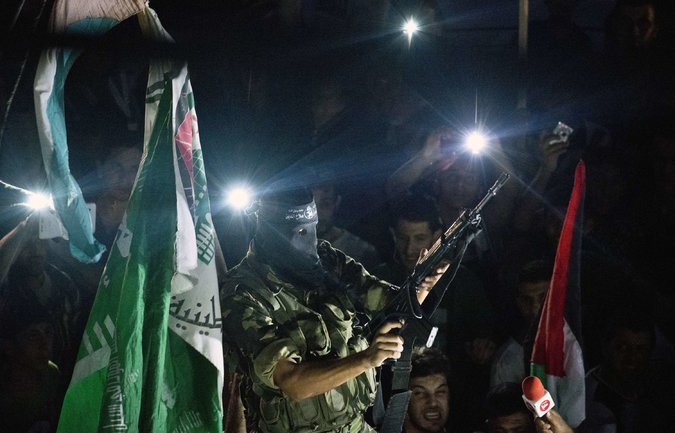GAZA CITY — Israel and Palestinian militants in the Gaza Strip on Tuesday reached a long-term cease-fire after seven weeks of fighting, according to officials on both sides, halting the longest, bloodiest battle either side has experienced in years — but without resolving many of the bigger issues underlying the conflict.
“Israel has once again accepted an Egyptian proposal for a complete cease-fire,” a senior Israeli official said on the condition of anonymity. “This cease-fire is unlimited in time.”
Shouts of “God is great” rang out from mosque loudspeakers across Gaza City, as people fired gunshots into the air to celebrate.
“We declare the victory of the Palestinian resistance, the victory of Gaza,” Sami Abu Zuhri, a spokesman for the militant Hamas movement that dominates Gaza and led the Palestinian militants’ operation, announced at a news conference at Al Shifa Hospital in Gaza City. “We achieved some of our instantaneous demands out of this battle.”
The agreement came on the 50th day of a conflict that has killed more than 2,100 Palestinians, most of them civilians, and destroyed thousands of homes and other buildings across Gaza, displacing at least a third of its 1.7 million residents. On the Israeli side, 64 soldiers and five civilians were killed – the last one even as the cease-fire was being announced, as mortar rounds from Gaza struck near a swimming pool on a kibbutz just beyond its border.

People familiar with the agreement said it would ease but not lift Israeli restrictions on travel and trade, largely reviving the terms of a 2012 cease-fire agreement that ended an eight-day air war. It also will allow construction materials and humanitarian aid to enter Gaza in large quantities for a major rebuilding effort, with a monitoring mechanism to ensure that concrete and cement would go only to civilian purposes.
“We’re not interested in allowing Hamas to rebuild its military machine,” the senior Israeli official said.
Other issues — including Hamas’s demand for a Gaza seaport and airport, Israel’s demand for Gaza’s demilitarization, and the return of Israeli soldiers’ remains believed to be in Hamas’s hands — were to be addressed after a month if the truce holds, people familiar with the agreement said.

Drafts of a document outlining cease-fire terms had been passed back and forth throughout the day on Tuesday, even as Israeli airstrikes killed at least half a dozen people in Gaza and felled two high-rise buildings. More than 100 rockets from Gaza also rained down on Israel’s battered south, continuing even beyond the 7 p.m. deadline that some officials said marked the onset of the cease-fire. The mortar that killed the Israeli around 6:30 p.m. wounded six others, two of them seriously, according to a spokesman for the Israeli police.
In Ashkelon, the Israeli city less than 10 miles from Gaza, a long-range rocket destroyed one home, damaged dozens of others and sent 20 injured people to the hospital, the most in a single strike this summer. The rocket smashed through the red-tile roof of the home where Yuval and Ofra Cohen had lived for 10 years with their children, now 14 and 17, according to the Israeli police and Ynet, an Israeli news site.
“We hadn’t managed to make it into the safe room when it fell in our bedroom,” Mr. Cohen said in an interview on Army Radio. “It caught us in the children’s room, all the shrapnel and the dust and all of the glass. I don’t know how we escaped without harm, it’s a miracle.”

In Gaza, the Health Ministry said two people were killed in an afternoon airstrike in east Gaza City. Two others died in a drone attack in the territory’s north, and two more were killed in an airstrike at dawn, the ministry said. Voice of Palestine radio said that more than 20 homes had been destroyed overnight.
Israel’s felling of two Gaza City towers took place in the early hours on Tuesday, after having destroyed an 11-story Gaza City apartment tower on Saturday.
The high-rise destroyed on Tuesday, known as the Italian Compound, had 13 floors, with four apartments on each floor. It rose above an 80,000-square-foot mall with seven shisha cafes surrounding a garden and shops selling shoes, pharmaceuticals and mobile-phone accessories, as well as the Hamas-controlled Ministry of Public Works. It was one of Gaza’s finest residential buildings, with 24-hour guards, and generators and wells to keep the elevator running and taps flowing when electricity and water ran short.

On Tuesday morning, the apartment line on the southeast corner and the elevator shaft were all that was left after a series of Israeli airstrikes that started after midnight, injuring about a dozen residents and leaving 40 families homeless.
“We spent the whole night in the street outside because it was dangerous to move,” said Hani Ashi, 44, who bought his 1,750-square-foot apartment on the tower’s fifth floor for $63,000 four years ago. Mr. Ashi said he had fled in shorts and a sleeveless undershirt, carrying only his family’s identity cards and a jalabiya, or cloak, which he donned when he got outside.
Zaki Shneino, a guard who has worked at the building for 10 years, said one of the tower’s apartments was hit earlier this summer; it was owned by Dirar Abu Sisi, an engineer whom Israel captured in Ukraine in 2011 and who has since been held in prison on charges that he designed Hamas weaponry, Mr. Shneino said. Shortly after midnight on Tuesday, several residents received calls on their mobile phones advising them to evacuate.
Mr. Ashi, who lived on the fifth floor with his wife and eight children, the youngest of them 10-year-old twins, said there were four drone-fired missiles, warning shots that Israel calls “knocks on the roof,” 10 to 20 minutes apart, then six or seven bombs dropped by F-16 warplanes.
By late morning, uniformed police officers and detectives in plain clothes prevented journalists and others from getting close to the rubble of the building, where bedcovers, cooking-gas cylinders, a computer and an 11th-grade textbook could be glimpsed among the debris. A man was loading boxes of unsold shoes into a van, while a cafe owner recovered bamboo chairs whose dark-red seat coverings had turned gray from the dust.
Residents said 40 of the tower’s 52 apartments had been occupied, many of them by doctors, merchants, engineers and other professionals. It was built by a Palestinian-Italian company, they said, and opened in 1998 or 1999.
“Prices here are a little bit higher than other buildings,” said Mr. Ashi, who worked as a police officer for the Palestinian Authority before it was routed by Hamas in 2007, and then for 10 months in the Hamas-controlled security service. “Because this is a distinguished place.”
The other building hit Tuesday morning was Al Basha, a 12-story office tower over four stores, including one that sold bathroom tiles and fixtures and one showcasing Palestinian-made juice. Some people whose homes elsewhere in Gaza had been destroyed during the summer’s fighting had been staying in the building’s basement.
Hamas officials had taken over spaces in Al Basha in 2009 after some of their headquarters were destroyed in Israel’s winter incursion, posting paper signs saying they were information technology companies. But most had moved out after offices were rebuilt.
A guard who gave his name only as Abu Ismail said an Arabic speaker who identified himself as representing the Israeli military had called his mobile phone twice as a warning before the strikes began about 4:20 a.m. First came three “knocks on the roof,” he said, followed by four F-16 bombs.







